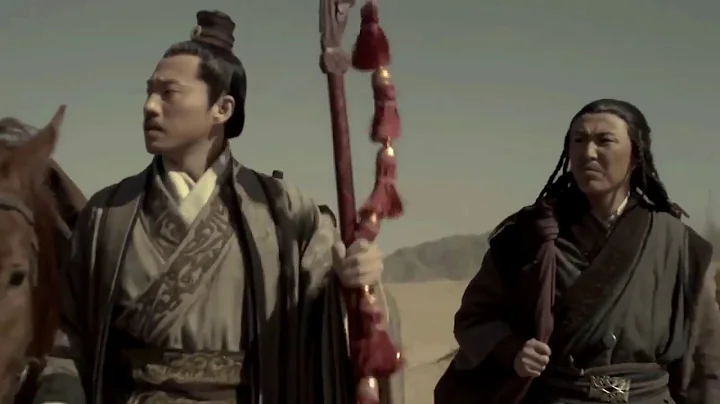Emperor Xian of the Han Dynasty The 24th year of Jian'an, which is 219 AD. Liu Bei The "Commander-in-Chief" of the Jingzhou Military Region Guan Yu led his troops north to attack Wei, cooperating with Liu Bei's "Hanzhong Offensive" launched in northern Yizhou, intending to use this opportunity to hit Cao Wei hard and speed up the process of unifying the country.

01| Why did Guan Yu attack Xiangfan ? In order to allow Liu Bei's army to gain the strategic advantage, the strategic goal of Guan Yu's campaign was to capture Fancheng and Xiangyang in the middle reaches of the Han River, which echoed the Hanzhong in the upper reaches of the Han River. In this way, Liu Bei's group's mobile troops - mainly ① Jingzhou Army led by Guan Yu and ② Chengdu Army led by Liu Bei, allowed these two armies to quickly dispatch through the Han River. As the saying goes, "the three armies have not moved, but food and grass go first." If Xiangfan is occupied, Liu Bei's two armies will use the Han River for water transportation dispatch, which will be much faster than Cao Cao 's land mobilization.

In this way, whether he is sending troops from Xiangfan to attack Henan and Hebei, the hinterland of Cao Cao's power, or sending troops from Hanzhong to seize Cao Cao's Guanzhong area, Liu Bei can use the Han River to quickly complete the assembly and dispatch of superior forces. You can even flexibly switch the focus of your attack!
Liu Bei's army knows this, and Cao Cao's army also knows it very well. Therefore, Cao Cao's army was strictly guarding the Xiangfan defense line. Before the Battle of Hanzhong, Guan Yunchang had no chance to capture Xiangfan. But Liu Bei's Battle of Hanzhong brought a turn for the better.

02| Guan Yu’s three major advantages when attacking Xiangfan
- The first advantage was that Cao Wei’s troops were stretched thin and Xiangfan’s defense was empty.
After the Battle of Chibi , Cao Cao retreated. Liu Bei and Cao Cao faced off at the Xiangfan defense line, while Sun Quan and Cao Cao faced off at the Jianghuai defense line. In fact, these two lines of defense have been the focus of competition among Chinese dynasties for nearly 2000 years.
On the eastern front, starting from 214 AD, Cao Cao continued to attack Sun Quan. By 217 AD, Cao Wei stationed a large number of troops in Anhui. On the Western Front, in 215 AD, Cao Cao sent troops to attack Dongchuan Zhang Lu , and in 218 AD he marched to attack Xichuan Liu Bei. By the beginning of 219, on the western front, " Xiahou Yuan was beheaded" and both sides "spent months together, and many Wei soldiers died"; on the eastern front, All the soldiers were stationed in Hefei.

In other words, Cao Wei's main force will either confront Liu Bei in Hanzhong or confront Sun Quan in Hefei. Cao Ren who was guarding Xiangfan was weak and suddenly became the soft waist and abdomen between the left and right iron fists of the Wei army, and was directly exposed to Guan Yu's military front. This was Guan Yu's strategic opportunity to attack Cao Wei.
- Guan Yu’s second biggest advantage is Liu Bei’s advantage in the Battle of Hanzhong.
After Liu Bei gained the advantage in Hanzhong, Mengda and Liu Feng's troops occupied the eastern part of Hanzhong and pushed the front directly to the edge of Xiangfan. and Guan Yu formed a pattern of flanking Cao Ren from the west and south. In addition to the first point, the main force of the Wei army in the west is in Hanzhong and the main force in the east is in Hefei, both of which are far away from Cao Ren. As a result, Cao Ren suddenly became a lonely and deep-reaching force, with the possibility of being annihilated.

- Guan Yu’s third major advantage is the arrival of the flood season.
In the dry season, although Hefei is far away, Cao Wei's cavalry can still quickly support Cao Ren, and Guan Yu may not dare to act rashly. However, with the arrival of the flood season, Cao Wei's elite cavalry was unable to gallop, while Guan Yu's navy was able to "cross the four seas."
Guan Yu, who had been the guard of Jingzhou for many years, built a defense system with Jiangling and Public Security as the core nodes in the northern part of Jingzhou, and established a military force with the navy as the main force. When the flood season comes, Guan Yu's use will also come.

Some capable people in Cao Wei have figured out these three points.For example, Cao Wei's Yangzhou governor Wen Hui made a very precise discussion on this. He said: "Although there is Sun Quan in Hefei, it is not a cause for concern. The real threat lies in Guan Yu in the south. Now that the flood season has arrived, the weather is about to rise. The water is gone, and Zixiao (Cao Ren, also known as Zixiao) is alone and difficult to defend. If Guan Yu takes the opportunity to attack, great trouble will occur!"
Sure enough, Guan Yu took advantage of the flood season to send troops to attack Xiangfan.
03| Guan Yu's wrong decision: the more he fought, the more he forgot the strategic goal.
Guan Yu's battle in Jingzhou was very "beautiful" in the early stage. flooded the Seventh Army and besieged Fancheng. They successively repelled the seven reinforcements of Cao Wei and Wei. They used their troops elegantly and were quite the style of the Western Han Dynasty rangers.
However, although Guan Yu fought very well tactically, his strategic goals became increasingly blurred. Guan Yu's battle this time was not to annihilate Cao Wei's army, nor to capture many high-ranking officials and generals of Cao Wei. But to seize Xiangfan, especially Xiangyang City that "sits" directly on the Han River!

However, Guan Yu did not regard Xiangyang as the key direction of attack. Even the siege of Fancheng was "siege but not attack". Instead, he focused on annihilating Cao's army and failed to realize the urgency and importance of capturing Xiangyang. . When Cao Wei decided to make peace with Sun Quan, give up his interests in the east, withdraw his troops from Hanzhong, and concentrate on supporting Xiangfan, Guan Yu's defeat was only a matter of time.
04| Guan Yu's defeat: Three major advantages were lost, but Guan Yu did not adjust in time.
- The first change: Comparative adjustment of forces
After Cao Jun returned to the army, Guan Yu did not capture Xiangyang, so he did not receive support from the Chengdu Army. But Cao Ren was able to obtain a steady stream of reinforcements. Guan Yu suddenly changed from a superior force to a weak force, and Guan Yu's "encirclement and reinforcements" directly turned into Cao Ren's "central flowering". As a result, the dynamics of strength and weakness changed.
- The second change: Sun Quan defected
If we say that Liu Bei captured the three eastern counties, Guan Yu, Liu Feng, and Meng Da semi-surrounded Cao Ren. So when Sun Quan defected, Guan Yu became the one semi-surrounded. At this time, Guan Yu should have retreated, abandoned Jingzhou, returned to Dongsan County, and joined forces with Liu Feng and Meng Da.

Sun Wu crossed the river in white clothes
However, Guan Yu committed the problem of being proud and arrogant. He could not accept the fact that he had lost Jingzhou, so he delayed outside Jiangling City for too long and forced Liu Feng and Meng Da to rebel, bringing him from a "semi-siege" situation to a "total siege" situation. situation. It's really depressing.
- The third change: The flood season has passed
Jingzhou has many naval forces, and they cannot defeat Cao Wei's cavalry in land battles. The flooding of the Seventh Army happened in July, while Lü Meng's crossing of the river in white clothes happened in the leap tenth month. Four months had passed. The flood season has long passed, and the combat environment for Guan Yu's troops has also changed from an advantage to a disadvantage.
In this way, Guan Yu's three major advantages and opportunities when sending troops have been completely lost.

Guan Yu seized this once-in-a-lifetime opportunity to attack, but made the wrong decision and chose to destroy the Wei army instead of seizing key areas so that the Shu and Han armies could support each other. But when the once-in-a-lifetime window passed, Guan Yu did not openly admit his mistakes and accept the reality. In fact, judging from the situation at the time, even if Sun Quan did not rebel, Guan Yu would definitely be defeated by Cao Cao.
A single mistake in decision-making actually led to the destruction of the three armies. It is really sad.

References:
[1] Fang Shiming. Why the "Crossing Jingyi" plan of "Longzhong Dui" was shattered——On the responsibility of Liu Bei and Guan Yu for the loss of Jingzhou [J]. Academic Monthly , 1997(02 ):53-60
[2] Wei Dianwen. Guan Yu was ordered to conquer the north [J]. Social Sciences, 1993(04):68-72.
[3] Wang Yanwu. The relationship between Guan Yu’s defeat and Liu Bei[J]. Jianghan Forum, 2003 (07): 68-71.
[4] Yang Debing . An attempt to solve the mystery of Guan Yu’s Northern Expedition [J]. Wei, Jin, Southern and Northern Dynasties Sui and Tang Historical Materials, 1994 (00): 70-81.







![Chu-Han Rebels vs Imperial Qin [ENG SUB] 刘邦项羽苦战秦军 - DayDayNews](https://i.ytimg.com/vi/n8W7D3CAp3o/hq720.jpg?sqp=-oaymwEcCNAFEJQDSFXyq4qpAw4IARUAAIhCGAFwAcABBg==&rs=AOn4CLCEhYn2GhSDu1BEYRdwg6cYFSQsVQ)









![5 HOURS OF SCI-FI STORIES [CALMING RAINSTORM SOUNDS] | Scary Stories to Help you Fall Asleep - DayDayNews](https://i.ytimg.com/vi/1rc0d5Sp4Ic/hq720.jpg?sqp=-oaymwEcCNAFEJQDSFXyq4qpAw4IARUAAIhCGAFwAcABBg==&rs=AOn4CLBtQifkPJGd2Y12FoG8LZ7LC_ACqw)



